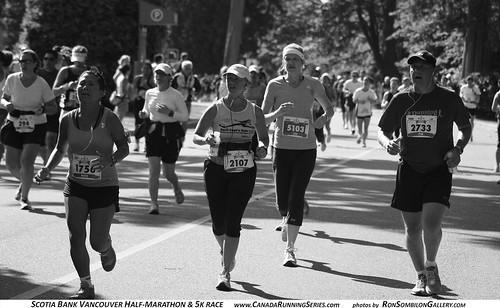
Over the last year I’ve really been getting into running. I’m training, reading books, signing up for races, and I keep getting more and more into it. Not bad considering I hated running a mere year ago.
As I find myself doing races, I’ve been getting more serious about my ‘training’. That is, rather than just going out for jogs after work, I’ve been trying to follow programs, add new types of workouts to the routine, look at nutrition, and so forth. It’s a gradual process.
Anyways, one of the more interesting tid-bits I’ve come across is running cadence. That is, how many steps you take over a certain period of time (1 minute). What’s so interesting about cadence? Well, it turns out elite runners almost always seem to have a cadence of about 180-190. All of them! Over any pace and distance, from 800m to marathon! This means over the course of a minute, each foot will strike the ground 90-95 times each. That’s fast. A lot faster than my cadence.
Determining your cadence is easy. Simply start your watch and count how many steps you take with one of your feet over 30 seconds. Double that to get your cadence over 60 seconds. Then double it again to get your total cadence (to include your other foot). When I did this I was in the 160 range. Not very good.
But what is it that makes a higher cadence ‘good’? Active.com gives us this explanation:
If you have a low stride rate you are likely producing more vertical oscillation. This means you are projecting energy and motion upwards instead of forward, and producing greater impact forces. Running should be akin to flying with your feet briefly touching the ground. An elite runner’s feet touch the ground for as little as one tenth of a second per stride. The more time your feet spend on the ground, the more energy you are wasting. You want to aspire to a stride rate of 180-190 strides per minute. If you are a beginner in all likelihood your stride rate is closer to 170 strides per minute, or lower. Don’t worry about your stride length; your stride will naturally lengthen as your stride rate increases.
So, we now know a higher cadence makes us more efficient, better runners and we know our current cadence. How do go about improving cadence?
Well, practice. Consciously work on your cadence during your runs. It will take time, but focusing on shorter, faster strides will eventually begin to feel natural. One thing that can help is running with a metronome. This website has free downloadable .mp3 files for different beats per minute. (Its meant for people who play guitar and piano, but hey, you gotta be creative sometimes). I threw the 170 bpm file on my mp3 player and went out on a run. I happened to be thinking of my cadence when the track began to play. At first, I thought Will Ferrell had jumped into my playlist was about to announce that we needed more cowbell, before I realized it was the metronome going tock-tock-tock-tock-tock. Matching my foot strikes to the beat felt fast, uncomfortably so. But that’s a good thing, and its how I’m going to improve. Once 170bmp feels natural I’ll move up to the 175bmp file, and so on. I don’t expect this to happen over weeks, but most likely months.
A word of advice, the .mp3 files are short, so you may want to put you iPod on repeat, or copy and rename the file multiple times so it plays randomly throughout your playlist.



